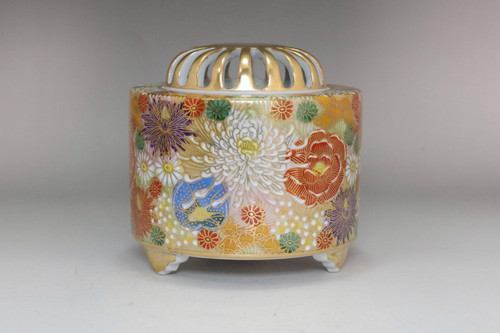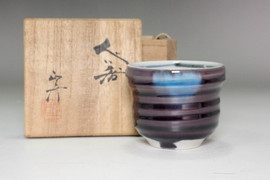Vintage Kutani porcelain incense burner #4961
- SKU:
- 4961
- Condition:
- Used
- Shipping:
- Free Shipping
- width: approx. 11.5cm (4 17⁄32in)
- height: approx. 10.3cm (4 1⁄16in)
- weight: 358g
This beautiful incense burner is adorned with vibrant flowers and colorful patterns that captivate anyone who sees it. The gold finish covering the entire piece exudes a sense of luxury, with chrysanthemums, peonies, and plum blossoms delicately depicted. Each flower is vividly colored, embodying a sophisticated design that conveys the beauty of traditional Japanese aesthetics to the modern era. This exquisite piece adds a refined Japanese accent to any room, evoking a sense of tranquility and elegance with every use.
Kutani porcelain
The history of Kutan ware goes back to around 1655 (first year of Meireki Era), early years of Edo Period.
Maeda Toshiharu, the first feudal lord of Daishoji domain which was a branch domain of Kaga, focused on the fact that pottery stones were found at a gold mine in his territory of Kutani (present-day Kutani, Yamanaka-machi, Ishikawa-prefecture), and he ordered Goto Saijiro, who officiated as a person in charge of gold refining at the mine, to learn about porcelain manufacturing at Arita in Hizen.
The Kutani ware is said to have begun at the time of building a kiln in Kutani through the introduction of the technology.
The kilns in Kutani were suddenly closed about 1730 (15th year of Kyoho Era), but the cause of it is still unknown.
Porcelains made during this period are presently called Ko-kutani (old Kutani), and as a typical Japanese porcelain decorated with colored pictures, their unique and strong beauty of the style is highly evaluated.
Since the late Edo period, Kutani ware has been revived through the efforts of the Kaga clan and potters.
The environment surrounding Kutani ware changed during the Meiji period (1868-1912), when Ishikawa prefecture lost the protection and support of the Kaga and Daishoji clans, and followed the Meiji government’s efforts to promote industry and export by participating in world expositions in Europe and the United States and holding domestic industrial expositions. This led to a dramatic increase in the production and sales of Kutani ware as industrial Kutani.
In this way, Meiji Kutani spread throughout the world under the name of “Japan Kutani,” and by around 1887, it had come to occupy the top position among Japan’s ceramic exports. Most of the exports were large decorative pieces such as large decorative plates, incense burners, and large flower vases of about 1.5 meters that were converted into lamp stands, as well as many figurines and coffee and tea cup and saucer sets.

















